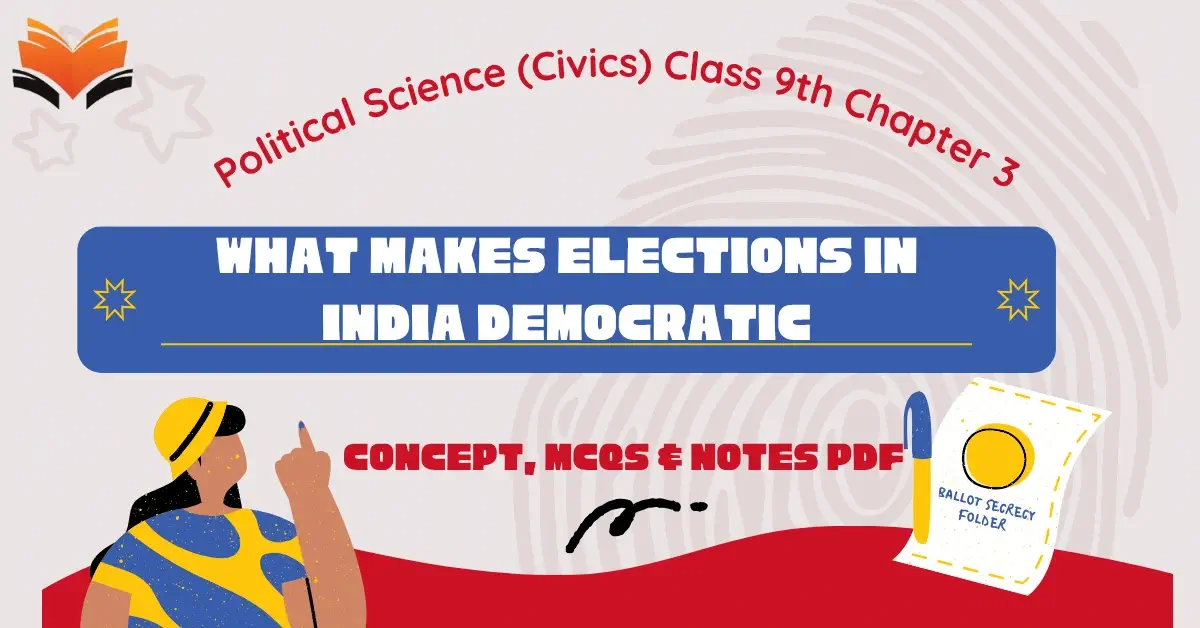What Makes Elections In India Democratic Class 9 – Concept & Notes PDF for Free
Topic covered: What Makes Elections In India Democratic class 9 notes and MCQs Questions: Electoral Politics (All single detail notes are exam-oriented).
We have discussed in-depth and exam-oriented pointers that can be asked in the board exam of class 9th about the “What Makes Elections In India Democratic?“ from the NCERT Political Science (Civics) notes for class 9th chapter 3 Electoral Politics.
Download the NCERT Political Science (Civics) for Class 9th Chapter 3 Electoral Politics Notes PDF
Download the NCERT Political Science (Civics) for Class 9th Chapter 3 Electoral Politics Notes PDF to get clear and reliable study material for your exams. These notes explain the concept of elections, their role in democracy, and how representatives are chosen in a simple and organized manner. Designed for Class 9 students, the notes cover all important topics and definitions from the chapter, making revision easier and faster. With this PDF, you can prepare step by step, understand key terms, and practice for your board exams with confidence. It’s a handy resource for quick learning and effective preparation.
What Makes Elections In India Democratic?
1. Issues Reported in Indian Elections:
- Allegations of unfair practices often appear in newspapers and TV reports.
- Common problems reported:
- Inclusion of false names in voters’ list.
- Exclusion of genuine names from voters’ list.
- Misuse of government facilities and officials by ruling party.
- Excessive money power used by rich candidates and big parties.
- Intimidation of voters and rigging on polling day.
2. Reality of Electoral Malpractices:
- Many reports of malpractices are correct, but…
- They are not widespread enough to defeat the purpose of elections.
- The basic question to ask:
- Can a party win power without popular support, relying only on malpractices?
3. Importance of This Question:
- This question is vital to judge the fairness of Indian elections.
- Answering it helps us examine whether elections in India are truly democratic.
Independent Election Commission
1. Importance of Election Commission:
- Fairness of elections depends on who conducts them.
- Key questions:
- Is the body independent of the government?
- Can the ruling party influence or pressurise it?
- Does it have sufficient powers and use them?
2. Independence of the Election Commission (EC):
- India has an independent and powerful Election Commission.
- EC enjoys the same kind of independence as the judiciary.
- The Chief Election Commissioner (CEC) is appointed by the President of India.
- Once appointed, the CEC is not answerable to the President or the government.
- The CEC cannot be easily removed, even if the ruling party dislikes the Commission’s actions.
- Very few election commissions worldwide have such wide-ranging powers.
3. Powers and Functions of the Election Commission:
- EC takes decisions on all aspects of elections, from announcement to results.
- It implements the Model Code of Conduct and can punish violators.
- It can direct the government to follow guidelines to prevent misuse of power.
- EC can order transfer of government officials during elections.
- Government officers on election duty work under the control of EC, not the government.
4. Role of EC in Ensuring Fair Elections:
- In the last 25 years, EC has actively exercised and expanded its powers.
- EC often reprimands government and administration for lapses.
- If polling is unfair in booths or constituencies, EC can order a repoll.
- Ruling parties may dislike EC’s decisions, but they are bound to obey.
- This proves the EC is both independent and powerful.
Popular Participation
1. Measuring Popular Participation:
- Quality of elections can be judged by enthusiasm of people’s participation.
- If elections are not free or fair, people lose interest and participation declines.
- Voter turnout is the main measure of people’s participation.
- Turnout = percentage of eligible voters who actually cast their vote.
2. Trends in Voter Turnout:
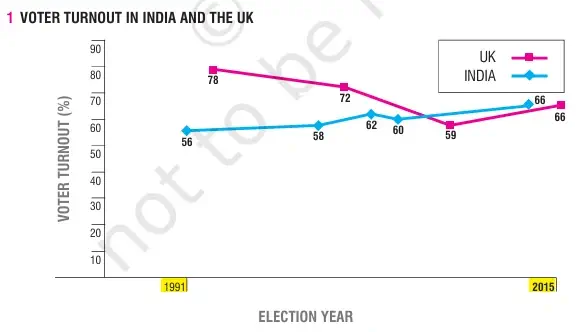
- In the last 50 years, Europe and North America have seen a decline in turnout.
- In India, turnout has remained stable or increased.
3. Participation of Social Groups:
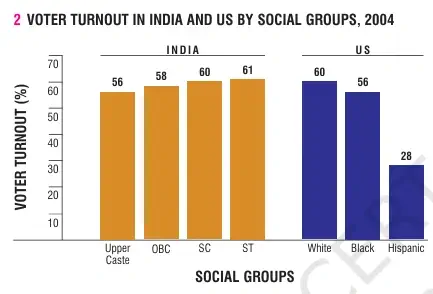
- In India, poor, illiterate, and underprivileged vote in larger proportion compared to rich and privileged.
- This is opposite to Western democracies like the USA, where:
- Poor, African Americans, and Hispanics vote less.
- Rich and white people vote more.
4. Importance of Elections for Common People in India:
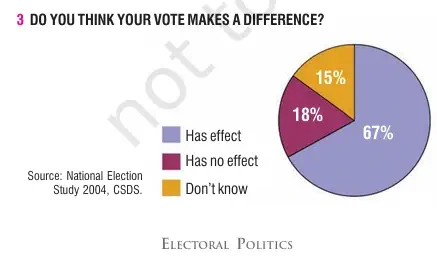
- People attach great importance to elections.
- They believe elections help in pressuring political parties to adopt policies in their favour.
- They feel their vote matters in how the country is run.
5. Increasing Voter Interest in India:
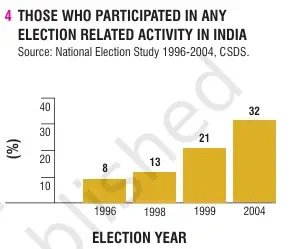
- Interest in election activities has been rising over the years.
- During 2004 elections:
- Over one-third voters took part in campaign-related activities.
- More than half of people identified themselves with a political party.
- 1 in 7 voters was a member of a political party.
Acceptance of Election Outcome
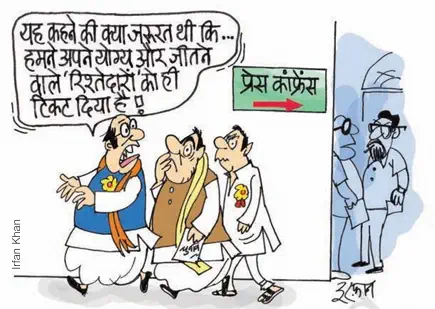
1. Test of Free and Fair Elections:
- The real test of free and fair elections lies in the outcome itself.
- If elections are not free or fair, the result always favours the powerful.
- In rigged elections, the ruling party usually does not lose, and the losing party does not accept the result.
2. Election Outcomes in India:
- In India, ruling parties routinely lose elections at both national and state levels.
- Out of every three elections in the last 25 years, the ruling party lost in two.
- About half of the sitting MPs or MLAs lose their elections in India.
3. Comparison with the US:
- In the United States, a sitting or incumbent representative rarely loses an election.
- In contrast, Indian elections show a higher chance of ruling representatives losing.
4. Candidates and Money Power:
- Candidates who spend heavily on buying votes often lose elections.
- Even those with criminal connections frequently face defeat.
5. Acceptance of Results:
- Apart from very few disputed elections, results in India are usually accepted as the people’s verdict by the losing party.
Challenges to Free and Fair Elections
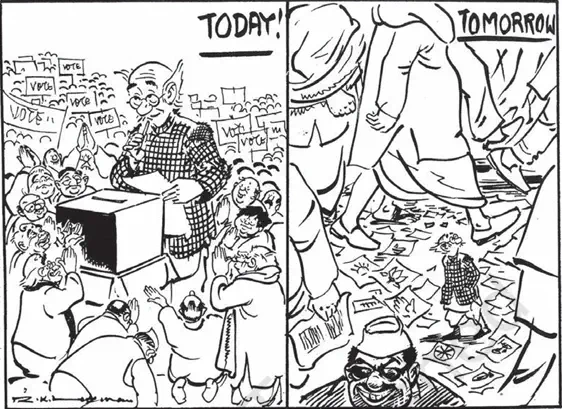
1. Free and Fair Elections in India:
- Elections in India are basically free and fair.
- The winning party forms the government because people have chosen it over rivals.
- In some constituencies, a few candidates may win using money power or unfair means.
- Overall, the verdict of a general election reflects popular preference.
- In the last 60 years, only a few exceptions have gone against this rule.
- This makes Indian elections democratic.
2. Deeper Questions about Elections:
Question 1. Are people’s choices based on real knowledge?
Answer:
- Often, voters do not have full knowledge about policies or candidates.
- Many decisions are influenced by money, caste, religion, or popularity rather than informed understanding.
- So, choices are not always based on real knowledge.
Question 2. Do voters get a real choice?
Answer:
- In many constituencies, the main political parties are quite similar in their policies and practices.
- This limits the range of real choices for voters.
- Thus, sometimes elections offer only a formal choice, not a meaningful one.
Question 3. Is the election a level playing field for all?
Answer:
- No, because parties with more money and resources have a clear advantage.
- Candidates with criminal connections or strong family backgrounds also enjoy unfair benefits.
- Smaller parties and independents face disadvantages, so it is not an equal field for all.
Question 4. Can an ordinary citizen realistically hope to win?
Answer:
- It is very difficult for an ordinary citizen to win due to lack of money, resources, and party backing.
- Dominance of wealthy candidates, criminals, and political families makes it hard for common people to succeed.
- So, the chances for ordinary citizens are very low.
3. Challenges to Indian Elections:
- Parties and candidates with money enjoy an unfair advantage over smaller parties and independents.
- Candidates with criminal connections push others out and secure tickets from major parties.
- Family dominance in political parties: tickets are often given to relatives.
- Elections often provide little choice, as major parties are similar in policies and practices.
- Smaller parties and independents face huge disadvantages compared to bigger parties.
4. Wider Context and Reforms:
- These challenges are present not only in India but also in many established democracies.
- Citizens, social activists, and organisations have been demanding reforms in the electoral system.
- Raises questions like: What reforms are needed? What can ordinary citizens do?
Key Terms and Definitions
- Code of Conduct: A set of norms and guidelines to be followed by political parties and contesting candidates during election time.
- Constituency: Voters in a geographical area who elect a representative to the legislative bodies.
- Incumbent: The current holder of a political office. Usually the choice for the voters in elections is between the incumbent party or candidate and those who oppose them.
- Level playing field: Condition in which all parties and candidates contesting in an election have equal opportunities to appeal for votes and to carry out election campaign.
- Rigging: Fraud and malpractices indulged by a party or candidate to increase its votes. It includes stuffing ballot boxes by a few persons using the votes of others; recording multiple votes by the same person; and bribing or coercing polling officers to favour a candidate.
- Turnout: The percentage of eligible voters who cast their votes in an election.
Next & Previous Topics of NCERT/CBSE Political Science (Civics) Class 9 Chapter 3: Electoral Politics
| Topics No. | Topics Name |
|---|---|
| 1 | Why Elections? |
| 2 | What Is Our System Of Elections? |
| 3 | What Makes Elections In India Democratic? |
MCQs on NCERT Political Science (Civics) Class 9 Chapter 3 Topic – What Makes Elections In India Democratic Class 9 Notes
Here are the top exam-oriented MCQ-type questions on “What Makes Elections In India Democratic Class 9 Notes” that you should prepare for your CBSE or state board exams:
Question 1. Which of the following is an example of malpractice in Indian elections?
a) Inclusion of false names in voters’ list
b) Misuse of government facilities by ruling party
c) Excessive use of money by candidates
d) All of the above
Answer: d) All of the above
Question 2. What is meant by “rigging” in elections?
a) Counting of votes twice
b) Fraud and malpractices to increase votes
c) Campaigning after deadline
d) Use of technology in elections
Answer: b) Fraud and malpractices to increase votes
Question 3. Who appoints the Chief Election Commissioner (CEC) of India?
a) Prime Minister
b) Parliament
c) President of India
d) Chief Justice of India
Answer: c) President of India
Question 4. Once appointed, the Chief Election Commissioner is:
a) Answerable to the President
b) Answerable to the Prime Minister
c) Not answerable to government or President
d) Answerable to Parliament
Answer: c) Not answerable to government or President
Question 5. The Election Commission of India enjoys the same independence as:
a) Media
b) Judiciary
c) Political parties
d) Bureaucracy
Answer: b) Judiciary
Question 6. Who controls government officers during election duty?
a) Ruling party
b) Election Commission
c) Chief Minister
d) Cabinet Secretariat
Answer: b) Election Commission
Question 7. What power does the Election Commission have if polling is found unfair in some booths?
a) Cancel elections permanently
b) Reprimand candidates
c) Order repolling
d) Dissolve government
Answer: c) Order repolling
Question 8. People’s participation in elections is usually measured by:
a) Number of candidates
b) Turnout percentage
c) Size of constituencies
d) Party manifestos
Answer: b) Turnout percentage
Question 9. In India, who participates more in voting?
a) Rich and privileged
b) Poor and underprivileged
c) Only educated voters
d) Only urban citizens
Answer: b) Poor and underprivileged
Question 10. Which group in the USA votes less compared to the rich and white population?
a) Asians
b) Hispanics and African Americans
c) Europeans
d) Immigrants
Answer: b) Hispanics and African Americans
Question 11. What proportion of voters took part in campaign-related activities during the 2004 elections?
a) One-fourth
b) One-third
c) Half
d) One-tenth
Answer: b) One-third
Question 12. According to NCERT, how many voters out of every seven are members of a political party in India?
a) One
b) Two
c) Three
d) Four
Answer: a) One
Question 13. In the last 25 years, in how many elections did ruling parties lose on average?
a) One out of three
b) Two out of three
c) Three out of three
d) None
Answer: b) Two out of three
Question 14. In India, about how many sitting MPs or MLAs lose elections?
a) One-fourth
b) Half
c) One-third
d) Almost none
Answer: b) Half
Question 15. Candidates with money and criminal connections in India:
a) Always win elections
b) Often lose elections
c) Never contest elections
d) Are banned from elections
Answer: b) Often lose elections
Question 16. The defeated parties usually accept electoral outcomes in India as:
a) Fake verdict
b) People’s verdict
c) Rigged result
d) Temporary outcome
Answer: b) People’s verdict
Question 17. Which factor gives big parties unfair advantage?
a) Party symbol
b) Money power
c) Media coverage
d) None of these
Answer: b) Money power
Question 18. In some parts of India, candidates with criminal connections have:
a) Been denied tickets
b) Pushed others out of the race
c) Never contested
d) Always lost
Answer: b) Pushed others out of the race
Question 19. Which factor often dominates political parties in India?
a) Student leaders
b) Political families
c) Independent candidates
d) Women leaders
Answer: b) Political families
Question 20. Why do smaller parties and independents face disadvantage?
a) Lack of media support
b) Lack of resources compared to big parties
c) No party symbols
d) Lack of voters’ trust
Answer: b) Lack of resources compared to big parties
Question 21. The percentage of eligible voters who cast their votes is called:
a) Turnout
b) Quorum
c) Majority
d) Popular vote
Answer: a) Turnout
Question 22. The current holder of a political office is known as:
a) Nominee
b) Candidate
c) Incumbent
d) Representative
Answer: c) Incumbent
Question 23. A set of norms to be followed by political parties during elections is called:
a) Election rules
b) Code of Conduct
c) Party manifesto
d) Election guidelines
Answer: b) Code of Conduct
Question 24. A condition in which all parties get equal opportunities during elections is called:
a) Level playing field
b) Equal rights
c) Free contest
d) Equal campaign ground
Answer: a) Level playing field

